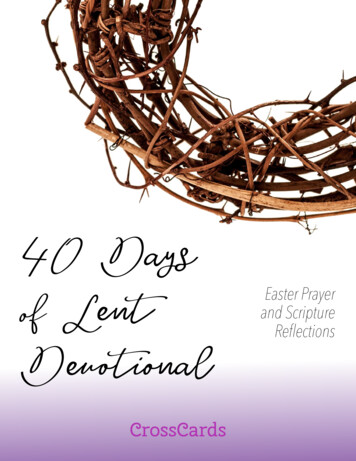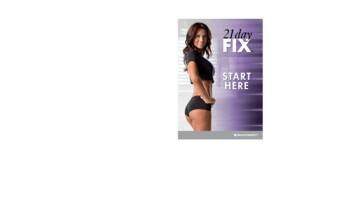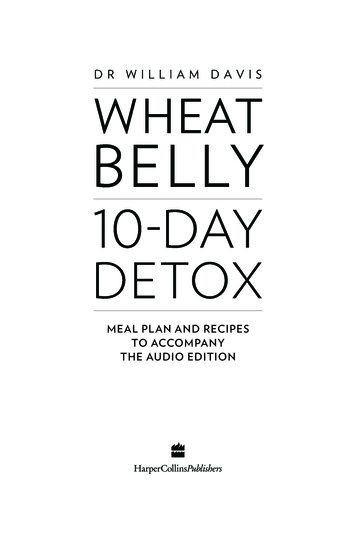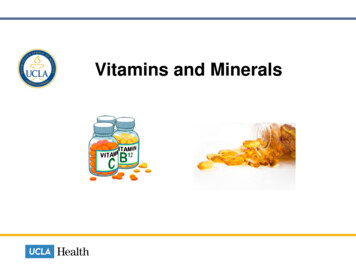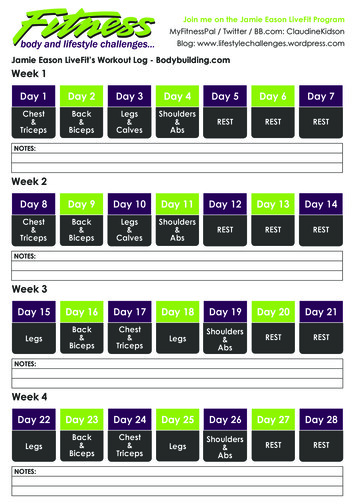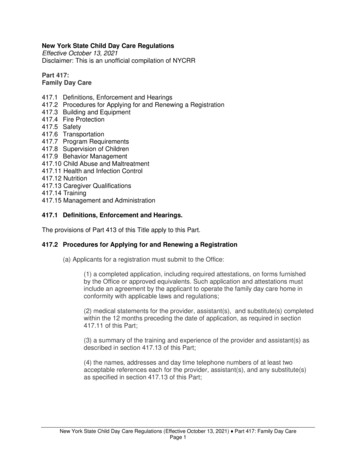
Transcription
New York State Child Day Care RegulationsEffective October 13, 2021Disclaimer: This is an unofficial compilation of NYCRRPart 417:Family Day Care417.1 Definitions, Enforcement and Hearings417.2 Procedures for Applying for and Renewing a Registration417.3 Building and Equipment417.4 Fire Protection417.5 Safety417.6 Transportation417.7 Program Requirements417.8 Supervision of Children417.9 Behavior Management417.10 Child Abuse and Maltreatment417.11 Health and Infection Control417.12 Nutrition417.13 Caregiver Qualifications417.14 Training417.15 Management and Administration417.1 Definitions, Enforcement and Hearings.The provisions of Part 413 of this Title apply to this Part.417.2 Procedures for Applying for and Renewing a Registration(a) Applicants for a registration must submit to the Office:(1) a completed application, including required attestations, on forms furnishedby the Office or approved equivalents. Such application and attestations mustinclude an agreement by the applicant to operate the family day care home inconformity with applicable laws and regulations;(2) medical statements for the provider, assistant(s), and substitute(s) completedwithin the 12 months preceding the date of application, as required in section417.11 of this Part;(3) a summary of the training and experience of the provider and assistant(s) asdescribed in section 417.13 of this Part;(4) the names, addresses and day time telephone numbers of at least twoacceptable references each for the provider, assistant(s), and any substitute(s)as specified in section 417.13 of this Part;New York State Child Day Care Regulations (Effective October 13, 2021) Part 417: Family Day CarePage 1
417.2(a)(5)417.2(a)(12)(5) sworn statements by the provider, assistant(s), substitutes and any person 18years of age or older who resides in the proposed family day care homeindicating whether, to the best of their knowledge, they have ever been convictedof a misdemeanor or a felony in New York State or any other jurisdiction, andfingerprint images as required pursuant to section 413.4 of this Article;(6) certification, on forms provided by the Office, of the status of the individualapplicant’s child support obligations or payments, in accordance with therequirements of Section 3-503 of the General Obligations Law;(7) certification, on forms provided by the Office, that the applicant is incompliance with workers compensation requirements of New York State law;(8) Statewide Central Register of Child Abuse and Maltreatment and JusticeCenter for the Protection of Persons with Special Needs(i) the Statewide Central Register Database Check forms necessary tocomplete required screening by the Statewide Central Register of ChildAbuse and Maltreatment to determine if the provider, employee(s),volunteer(s), and any person 18 years of age or older who lives in theprospective family day care home is the subject of an indicated report ofchild abuse or maltreatment;(ii) the forms necessary to check the register of substantiated categoryone cases of abuse or neglect maintained by the Justice Center for theProtection of Persons with Special Needs pursuant to Section 495 of theSocial Services Law.(9) a medical statement on forms furnished by the Office or approved equivalentsregarding the health of all persons residing in the family day care homecompleted within the 12 months preceding the date of application, as required insection 417.11 of this Part;(10) a statement from the appropriate local official or authority that the dwellingmeets standards for sanitation and safety, where the Office notifies the applicantthat such a statement is required;(11) where a registrant uses a private water supply,(i) a report from a state licensed laboratory or individual, based on testsperformed within the 12 months preceding the date of application,showing that the water meets standards for drinking water established bythe New York State Department of Health; or,(ii) if the water does not meet such standards, a description of how waterfor all purposes will be provided by another method acceptable to theDepartment of Health;(12) a report of inspection performed within the 12 months preceding the date ofapplication, by local authorities or an inspector qualified to approve fuel burningNew York State Child Day Care Regulations (Effective October 13, 2021) Part 417: Family Day CarePage 2
417.2(a)(12)417.2(d)(1)systems which documents approval of any wood or coal burning stove, fireplace,pellet stoves or permanently installed gas space heater in use at the home;(13) certification, on forms provided by the Office, that the dwelling, its propertyand premises, and the surrounding neighborhood and environment are free fromenvironmental hazards. Where the historical or current use of the dwelling, itsproperty and premises, or the surrounding neighborhood indicate that anenvironmental hazard may be present, inspection or testing must be completedby the appropriate local official or authority to determine if such hazard exists.Documentation of the inspection or testing must be appended to the statementrequired by this paragraph and include a statement from the appropriate localofficial or authority following this inspection and/or testing that the dwelling, itsproperty and premises, and the surrounding neighborhood, meet applicablestandards for sanitation and safety. Such hazards include but are not limited to,dry cleaners, gas stations, nuclear laboratories or power plants, propertydesignated as a federal superfund clean-up site, and any property with knowncontaminated ground or water supplies;(14) the site to be used for child care must meet the definition and requirementsof a personal residence as outlined in Part 413. The registrant must submitdocumentation, acceptable to the Office, to prove that the family day care site isbeing used as a residence and;(15) a health care plan developed in accordance with requirements of section417.11(c): and(16) an email address for the provider or other person designated to receivecommunications from the Office. If the applicant is unable to provide at least onevalid email address, the applicant must provide a valid mailing address for theprovider or other person designated to receive written communications from theOffice.(b) An application will only be accepted by the Office when the applicant submits theminimum threshold of information as required by Office policy. An application sent to theOffice that does not meet the minimum threshold will not be accepted and will bereturned to the applicant. Once an application has been accepted, all additional requiredinformation must be submitted within no later than 90 days. Failure to submit all requiredinformation within the required timeframes shall be considered a withdrawal of theapplication.(c) Applicants for a registration may not be issued a registration until an inspection of thefamily day care home has been conducted showing compliance with the requirements ofthis Part and the relevant provisions of the Social Services Law.(d) Renewal. Applicants for renewal of a registration must submit to the Office at least 60days in advance of the expiration date of the registration the following:(1) a completed application for renewal, including required attestations, on formsfurnished by the Office or approved equivalents. Such application andNew York State Child Day Care Regulations (Effective October 13, 2021) Part 417: Family Day CarePage 3
417.2(d)(1)417.2(d)(9)attestations must include an agreement by the applicant to operate the family daycare home in conformity with applicable laws and regulations;(2) certification, on forms provided by the Office, of the status of the individualapplicant's child support obligations or payments, in accordance with therequirements of Section 3-503 of the General Obligations Law;(3) certification, on forms provided by the Office, that the applicant is incompliance with workers compensation requirements of New York State law;(4) certification, on forms provided by the Office, that the dwelling, its propertyand premises, and the surrounding neighborhood and environment are free fromenvironmental hazards. Where the historical or current use of the dwelling, itsproperty and premises, or the surrounding neighborhood indicate that anenvironmental hazard may be present, inspection or testing must be completedby the appropriate local official or authority to determine if such hazard exists.Documentation of the inspection or testing must be appended to the statementrequired by this paragraph and include a statement from the appropriate localofficial or authority following this inspection and/or testing that the dwelling, itsproperty and premises, and the surrounding neighborhood, meet applicablestandards for sanitation and safety. Such hazards include but are not limited to,dry cleaners, gas stations, nuclear laboratories or power plants, propertydesignated as a federal superfund clean-up site, and any property with knowncontaminated ground or water supplies;(5) where a registrant uses a private water supply:(i) a report from a state licensed laboratory or individual, based on testsperformed within the 12 months preceding the date of the application forrenewal, showing that the water meets the standards for drinking waterestablished by the New York State Department of Health; or(ii) if the water does not meet such standards, a description of how waterfor all purposes will be provided by another method acceptable to theDepartment of Health;(6) a report of inspection and approval performed by local authorities or aninspector qualified to approve fuel burning systems, within the 12 monthspreceding the date of application for renewal of any wood or coal burning stove,fireplace, pellet stoves, or permanently installed gas space heater in use at thehome;(7) proof of compliance with the training requirements of section 417.14 of thisPart;(8) a statement from the appropriate local official or authority that the dwellingmeets satisfactory standards for sanitation and safety, where the Office notifiesthe applicant that such a statement is required; and(9) an email address for the provider or other person designated to receivecommunications from the Office. If the applicant is unable to provide at least oneNew York State Child Day Care Regulations (Effective October 13, 2021) Part 417: Family Day CarePage 4
417.2(d)(9)417.3(k)valid email address, the applicant must provide a valid mailing address for theprovider or other person designated to receive written communications from theOffice.(e) Applicants for renewal of a registration may not be issued a registration until aninspection of the family day care home has been conducted showing compliance withthe requirements of this Part and the relevant provisions of the Social Services Law.417.3 Building and Equipment(a) Each applicant must submit to the Office at the time of application for registration, adiagram of the proposed family day care home showing: all rooms in the home, includingthe rooms which will be used for day care and the purposes for which such rooms will beused; the number and location of exits and alternate means of egress; and the outdoorplay areas available to the children in care. An updated diagram must be submitted tothe Office immediately upon making any change that impacts the child care program.(1) Child care can only be provided in the areas of the family day care home thathave been included in the diagram and approved as child care space.(b) Rooms that will be used by the children must be well-lighted and well-ventilated.Heating, ventilating and lighting equipment must be adequate for the protection of thehealth of the children.(c) When care is provided, there must be sufficient light in the rooms where children aresleeping to allow supervision of and the safe movement and egress for the children.(d) A temperature of at least 68 degrees Fahrenheit must be maintained in all rooms tobe occupied by children.(e) A firm clean crib, cot, bed or washable padded mat of age-appropriate size andconstruction must be provided for all children requiring a rest period.(f) All cribs must be in compliance with the safety standards established by theConsumer Product Safety Commission. Stackable cribs are prohibited.(g) Toxic paints or finishes must not be used on room surfaces, furniture or any otherequipment, materials or furnishings which may be used by children or are within theirreach.(h) Peeling or damaged paint or plaster must be repaired.(i) Concrete floors in areas identified as program space must be covered withappropriate material.(j) The home must have adequate indoor space for the comfort of the children and toaccommodate a variety of activities for the number of children in care.(k) Each home must have access to outdoor space which is adequate for active play.Outdoor space may include public parks, school yards, or public play areas. A writtenNew York State Child Day Care Regulations (Effective October 13, 2021) Part 417: Family Day CarePage 5
417.3(k)417.4(d)plan or diagram outlining how children will safely travel to and from this location must bedeveloped and approved by the Office.(l) A bathroom not more than one floor level away from the program area must beaccessible to children.(m) All toilets and potty chairs must be located in rooms separate from those used forcooking, playing, sleeping or eating.(n) Adequate and safe water supply and sewage facilities must be provided and mustcomply with State and local laws. Hot and cold running water must be available andaccessible at all times.(o) All residences used for family day care homes must remain in compliance with theapplicable provisions of the Fire and Building Code of New York State, or otherapplicable fire and building codes when the Fire and Building Code of New York State isnot applicable.(p) The house or building number of the day care program shall be conspicuouslydisplayed and visible from the street.417.4 Fire Protection(a) Suitable precautions must be taken to eliminate all conditions which may contributeto or create a fire hazard.(b) Evacuation drills.(1) Evacuation drills must be conducted at least monthly during the hours ofoperation of the family day care home.(2) When conducting evacuation drills, the exit route must be varied to ensurethat all approved means of egress are practiced. If one of the exit routes leads toa window or fire escape, the drill must include taking the children to the windowor fire escape and explaining what would be expected of them should an actualfire occur that requires they use this exit route. Exiting through the window or onto the fire escape during a drill is not required.(3) When multiple shifts of care are provided, such drills must be conductedmonthly during each shift of care.(4) The registrant must maintain on file a record of each evacuation drillconducted, using forms provided by the Office or approved equivalents.(c) There must be an operational smoke detector on each floor of the home.(d) In addition to a smoke detector on each floor, there must be a smoke detectorlocated either within rooms where children nap, or in adjoining rooms. In the case ofrooms used for napping or sleeping which have doors, a smoke detector is requiredinside that room.New York State Child Day Care Regulations (Effective October 13, 2021) Part 417: Family Day CarePage 6
417.4(e)417.4(h)(3)(e) Where smoke detectors operate from electric power within the home, such detectorsmust have a battery powered back-up energy source, or battery powered smokedetectors must be used as a back-up system.(f) Multi-purpose fire extinguishers of a type approved for use in residences must bemaintained in good working condition and placed in the kitchen and outside the furnaceroom. A family day care program located in a multiple family dwelling is not required toplace or maintain a fire extinguisher outside the furnace room of such dwelling. Thecaregivers must know how to use the fire extinguishers placed in such home. Fireextinguishers with gauges must show a full charge. Fire extinguishers with seals musthave unbroken seals.(g) Children must be located on the same floor of the family day care home as acaregiver at all times, except as specified in section 417.8 of this Part. Children must notbe located above the second floor of a single family dwelling.(h) Children may be cared for only on such floors as are provided with readily accessiblealternate means of egress which are remote from each other.(1) Care can only be provided on floors with two means of egress. When care isprovided on the first floor, and the second floor is without a second means ofegress, the second floor may only be used for bathroom purposes provided thatthere is a window on the second floor that has the minimum net clear openingheight dimension of at least 24 inches and a minimum net clear opening widthdimension of at least 24 inches, and an adequate size through which all childrenand adults can be evacuated or a window that complies with the Fire andBuilding Code of New York State, or other applicable code if the Fire andBuilding Code of New York State is not applicable in that jurisdiction, as a meansof egress.(2) When care is provided primarily on the second floor of a family day carehome, both means of egress from the second floor must be stairways. Onestairway must be an interior stairway whose pathway is unobstructed and leadsdirectly to an unobstructed egress that is visible from the landing of the stairwayand the other stairway must either be an interior stairway whose pathway isunobstructed and leads directly to an unobstructed egress that is visible from thelanding of the stairway or be exterior to the house and lead directly to the ground.(3) Where children are located below ground level, one means of egress from thebelow-ground level area must be either an interior stairway whose pathway isunobstructed and leads directly to an unobstructed egress at ground level, or anexterior stairway which leads directly to the ground. The vertical travel to groundlevel may not exceed eight feet. The second means of egress may be a windowthat has the minimum net clear opening height dimension of at least 24 inchesand a minimum net clear opening width dimension of at least 24 inches, and anadequate size through which all children and adults can be evacuated or awindow that complies with the Fire and Building Code of New York State, orother applicable code if the Fire and Building Code of New York State is notapplicable in that jurisdiction, as a means of egress.New York State Child Day Care Regulations (Effective October 13, 2021) Part 417: Family Day CarePage 7
417.4(h)(4)417.5(b)(3)(iii)(4) All paths of egress on the interior and exterior of the home, includingcorridors, aisles and approaches must be kept free of obstructions, impedimentsand debris at all times.(i) Trash, garbage and combustible materials must not be stored in thefurnace room, or in rooms or outdoor areas adjacent to the home that areordinarily occupied by or accessible to children. If there is not a separate,enclosed furnace room, trash, garbage and combustible materials mustnot be stored within four feet of the furnace.(j) Wood or coal burning stoves, fireplaces, pellet stoves and permanently installed gasspace heaters used at any time at the home must be inspected and approved by localauthorities or an inspector qualified to approve fuel burning systems.(k) Kerosene and gasoline may not be stored in the habitable areas of the home, childcare areas, or path of egress.417.5 Safety(a) Suitable precautions must be taken to eliminate all conditions in areas accessible tochildren which pose a safety or health hazard.(1)The program must take suitable precautions to prevent the following:(i) serious injury of a child while in care at the program or beingtransported by the program; and(ii) death of a child while in care at the program or being transported bythe program.(b) The registrant must submit a written Emergency Plan and Emergency EvacuationDiagram using the forms furnished by the Office or an approved equivalent form.Primary emphasis must be placed on the safe and timely evacuation and relocation of allchildren. The plan must account for the variety of needs of children, including those withdisabilities.(1) The plan, as submitted with the application or changed thereafter, must bereviewed with the parents of the children in the program and all caregivers thatwork in the program.(2) The emergency evacuation diagram must be posted in a visible location.(3) The emergency plan must include the following:(i) how children and adults will be made aware of an emergency;(ii) a designation of primary and secondary evacuation routes;(iii) methods of evacuation, including where children and adults will meetafter evacuating the home, and how attendance will be taken;New York State Child Day Care Regulations (Effective October 13, 2021) Part 417: Family Day CarePage 8
417.5(b)(3)(iv)417.5(d)(iv) a plan for the safe evacuation of children from the premises for eachshift of care provided (day, evening, night);(v) the designation of primary and secondary emergency relocation sitesto be used in the case of an emergency, which prohibits re-entry to thepremises, and how the health, safety and emotional needs of children willbe met in the event it becomes necessary to evacuate to another location;(vi) a strategy for sheltering in place; and how the health, safety andemotional needs of children will be met in the event it becomes necessaryto shelter-in-place; and(vii) notification of authorities and the children's parents;(viii) roles of staff; and(ix) procedures related to the reunification of children and caretakers.(4) Each program must hold two shelter-in-place drills annually during whichprocedures and supplies are reviewed. Parents must be made aware of this drillin advance.(5) The registrant must maintain on file a record of each shelter-in-place drillconducted, using forms provided by the Office or approved equivalents.(6) Parents must be made aware of the primary and secondary relocation sitesand any changes to the plan in advance. In the case that a program is directed toa different location by emergency services, the program must notify parents andOCFS as soon as possible. In the event that relocation is required, a writtennotice must be placed on the main entry to the child care space unless animmediate threat precludes the program from doing so.(7) Each program must have on site a variety of supplies including food, water,first aid and other safety equipment to allow for the protection of the health andsafety of children in the event parents are unable to pick up children due to alocal disaster. The plan must take into account a child's needs for an overnightstay. Food supplies must be non-perishable and of sufficient quantity for allchildren for an overnight stay.(c) Portable electric heaters or other portable heating devices, regardless of the type offuel used, may not be used in rooms accessible to the children.(d) Radiators and pipes located in rooms occupied by children must be covered toprotect the children from injury when the heating system is in use.New York State Child Day Care Regulations (Effective October 13, 2021) Part 417: Family Day CarePage 9
417.5(e)417.5(g)(4)(iv)(e) Porches, decks or stairs with more than two steps must have railings with a barrierextending to the floor or ground to prevent children from falling. Acceptable types ofbarriers include, but are not limited to, balusters, intermediate rails, and heavyscreening.(f) Barriers.(1) Barriers must exist to prevent children from gaining access to any swimmingpool, drainage ditches, wells, ponds or other bodies of open water located on oradjacent to the property where the day care program is located. Such barriersmust be of adequate height and appropriately secured to prevent children fromgaining access to such areas.(2) Barriers must exist to prevent children from gaining access to unsafe,dangerous or hazardous areas or devices. Such areas and devices include, butare not limited to, holes, pits, wood, pellet and coal burning stoves, fireplaces andpermanently installed gas space heaters.(g) Pools and spas.(1) The use of spa pools, hot tubs and fill-and-drain wading pools is prohibited.(2) The use of non-public and residential pools is prohibited except in thoseinstances where the program can demonstrate the ability to operate andadequately supervise the use of a non-public or residential pool in a clean, safeand sanitary manner.(3) To use a non-public or residential pool, a program must:(i) provide to the Office documentation demonstrating that there will beadequate supervision of all children in care while children use the pool, inaccordance with the requirements of section 417.8 of this Part;(ii) submit documentation acceptable to the Office demonstrating thatconsistent, safe and adequate water quality of the pool will be maintained;and(iii) submit a written pool safety plan acceptable to the Office that setsforth adequate safety standards for use of the pool.(4) The Program must obtain prior written permission from the parent for his orher child to use the pool. Permission notes must include the following:(i) Name and age of the child;(ii) Address where the pool is located;(iii) The depth of the pool at its deepest point;(iv) Dates or months the child is permitted to swim in the pool; andNew York State Child Day Care Regulations (Effective October 13, 2021) Part 417: Family Day CarePage 10
417.5(g)(4)(v)417.5(l)(5)(v) Signature of parent and date signed.(5) A trained person as described in section 417.8(n) of this Part must be presentat the pool whenever the pool is in use by day care children.(6) Programs using non-public or residential swimming pools shall maintain acurrent and accurate record detailing the pool maintenance.(7) Only a program’s pool at the family day care site and public swimming poolsand bathing beaches that have a valid permit to operate issued from the localhealth department having jurisdiction for the bathing facility or those operated bya NYS agency may be used.(h) Public swimming pools and adjacent areas used by the children must be constructed,maintained, staffed and used in accordance with Chapter 1, subpart 6-1, of the NewYork State Sanitary Code, and in such a manner as will safeguard the lives and health ofchildren.(i) Protective caps, covers or permanently installed obstructive devices must be used onall electrical outlets that are accessible to children.(j) All matches, lighters, medicines, drugs, detergents, aerosol cans and other poisonousor toxic materials must be stored in their original containers, and must be used in such away that they will not contaminate play surfaces, food or food preparation areas, orconstitute a hazard to children. Such materials must be kept in a place inaccessible tochildren.(k) Cleaning materials must be stored in their original containers unless the product’suse or the program’s health care plan indicates that the product be mixed with waterbefore use. In this case, the container used for subsequent use of the mixed productmust state the name of the cleaning material contained within. Cleaning materials mustbe used in such a way that they will not contaminate play surfaces, food or foodpreparation areas, or constitute a hazard to children. Such materials must be kept in aplace inaccessible to children.(l) Animals and Pets.(1) Any animal present at the day care home must present no evidence ofdisease or parasite and pose no threat.(2) All animals present at the program that require a license must be licensed.(3) All required vaccinations must be kept current.(4) The license and record of vaccinations must be available to the Office whenrequested.(5) The program must immediately notify the parents of children in care and theOffice when an animal kept on the premises harms any person, including a childin care.New York State Child Day Care Regulations (Effective October 13, 2021) Part 417: Family Day CarePage 11
417.5(l)(6)417.5(o)(6) The provisions of this subdivision apply to all animals present at the programregardless of who owns the animal.(7) The program must provide parents with a written description of all animalskept on the premises prior to a child’s enrollment in the program.(8) Within twenty-four hours that an animal is first kept on the premises of a childcare program, the program must provide written notice to the Office and parentsof children in care that such animal is being kept on the premises(m) Communication.(1) A working telephone must be available for use by all caregivers at all timeschildren are in care.(2) The phone used at the family day care must remain in a designated visiblelocation during all hours that children are in care.(3) The phone used at the family day care must have a ringtone that remainsaudible throughout day care hours of operation.(4) All caregivers must be able to operate the phone used at the day careprogram.(5) 911 and the poison control phone number must be posted conspicuously onor next to the telephone.(6) Devices used for purposes of call blocking shall not be used to block incoming calls from parents of children in care, representatives of the Office oragents of the state or local government during the hours of operation of the childday care program.(n) Materials and play equipment.(1) Materials and play equipment used by the children must be sturdy and freefrom rough edges and sharp corners.(2) Play equipment must be in good repair, and be placed in a safe location.(3) Play equipment must be used in a safe manner.(4) Play equipment must be used specifically for its intended purpose. Suchequipment and apparatus may be used only by the children for whom it isdevelopmentally appropr
417.4 Fire Protection 417.5 Safety 417.6 Transportation 417.7 Program Requirements 417.8 Supervision of Children 417.9 Behavior Management 417.10 Child Abuse and Maltreatment 417.11 Health and Infection Control . inspection of the family day care home has been conducted showing compliance with


![Welcome [dashdiet.me]](/img/17/30-day-weight-loss-journal.jpg)
